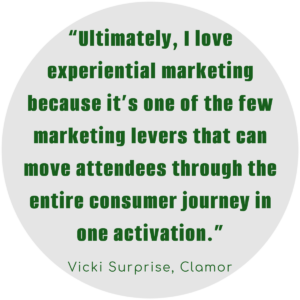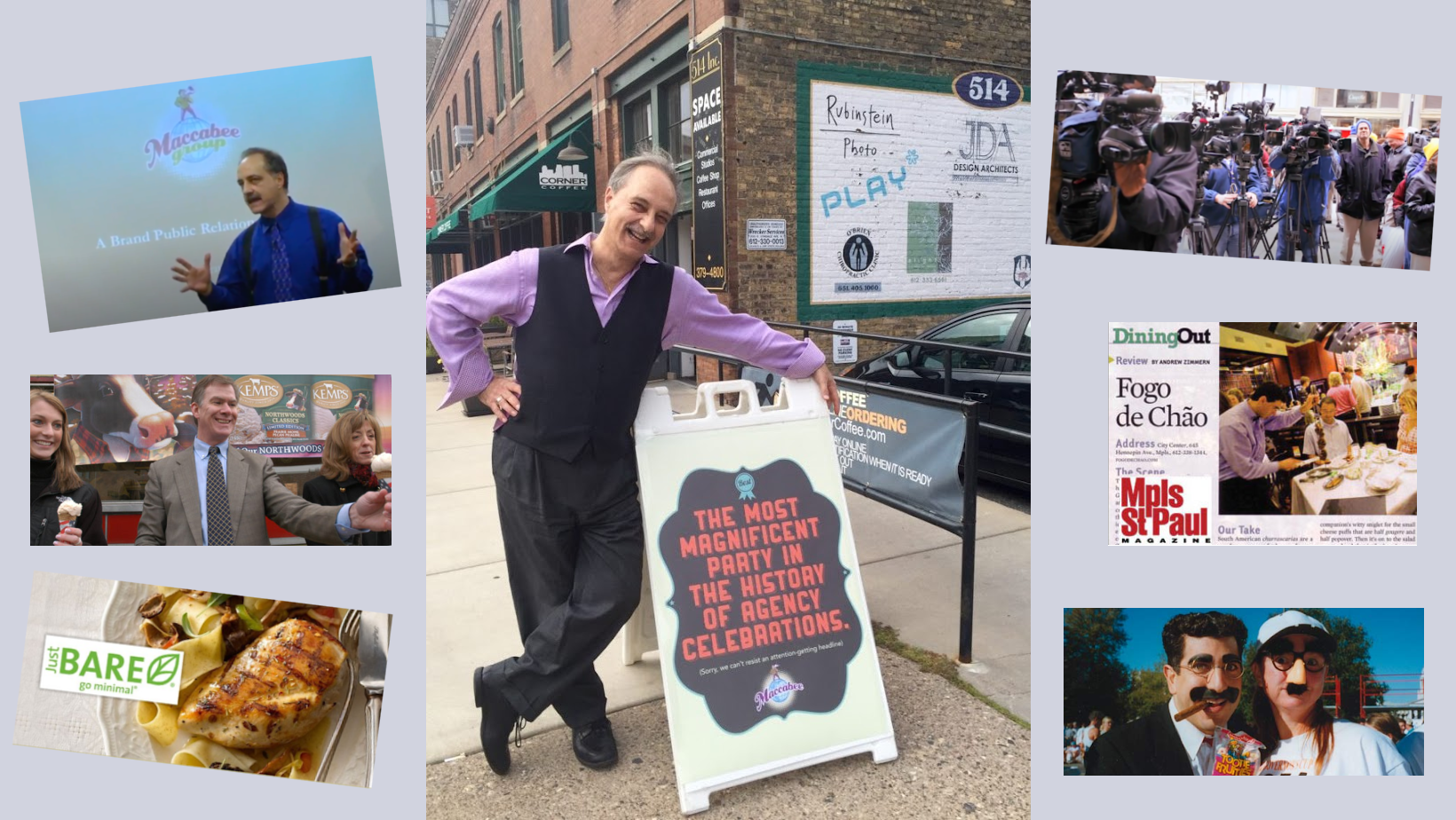5 Experiential Trends Every Brand Marketer Must Know For 2024
Over a year ago, I was surrounded by flames. Although, not in any life-threatening or crisis communications way that a typical PR professional might anticipate. Rather, living abroad in Edinburgh before joining Maccabee allowed me to lead experiential marketing efforts for the Beltane Fire Society: a Scottish non-profit that specializes in putting on modern Celtic fire festivals such as the summer Beltane and winter Samhuinn events for its 15,000 international attendees.
My role in steering Beltane out of the COVID-19 pandemic shadows by using meaningful online and street experiences provided a perspective on the profound transformation that swept through the experiential marketing landscape. Brands faced the challenge of reevaluating event strategies in a world where physical distance and incessant doom-scrolling on mobile devices have become the norm, even though they and their audiences simultaneously appear to desire deeper forms of connection.
In conversations with Minneapolis-based experiential industry mavens—Vicki Surprise and Erik Oelke from Clamor, which has worked with GE HealthCare, Driscoll’s, US Bank and NBC Sports, and Jim Audette from Street Factory Media, which has worked with Fender, Samsung and Impossible Foods—we unraveled the challenges and predictions for how you can best use experiential marketing, including how PR could propel the industry further in its 2024 success.
Adapting to Change in Experiential Marketing
Experiential marketing is centered around crafting memorable and immersive experiences. However, the onset of the COVID-19 pandemic presented challenges to the industry, particularly with large events, group activations and product sampling.
How could experiential marketers provide the same in-person value with health-aware restrictions? According to Surprise, the event industry faced a critical moment. “At the time, standard experiential efforts needed to change to ensure our activations were safe and relevant during a pandemic. That’s why we leaned into our mobile tours that took place outdoors, weren’t reliant on events happening, and tapped into influencer kits.” She emphasizes their enjoyment in now creating wherever-you-are experiences such as a “French café in a box” to drive viewership and excitement among high-profile influencers and their followers for the upcoming 2024 Paris Olympics.
“Never underestimate the ability of a creative media kit,” Audette chimes in, praising its growing importance in the industry and sharing an example of a stereo and cassette tape media kit that Street Factory developed for a partnership launch with Reebok and Cardi B. “When a brand commits to elevating a media kit, it can really pay off. The trend of curating intimate, elaborate and exciting experiences for audiences where they’re at will only continue as more consumers desire brands to make introductions that are warm, adaptable and creatively personable.”
What Does “Immersive” Really Mean in Experiential Marketing?
In the ever-evolving marketing landscape, the term immersive has emerged as a powerful phrase, signaling the way your brand can connect with its audiences. For marketers, immersive experiences are crafted by deeply knowing their audience and subject matter. Making everything from physical touchpoints to messaging cues hyper-relevant to the ‘super fan’ – whether that’s a fan of a particular movie, sports team, etc. – is the key. This means getting the details right and then going one level deeper to make people feel like the event was created just for them.
Surprise agrees, mentioning experiential marketers define ‘immersive’ as consumers leaving an experience knowing more about the brand and feeling exactly what they wanted to communicate. “Experiential marketing is not just renting out a bar that is streaming a show. Instead, it’s making it a home for the show’s fans, wherever they are. Experiential marketers need to dial into what the fans will love about the experience to meaningfully bring it to life.”
Audette adds that every layer of experiential marketing provides impact, emphasizing the power of small activations such as Street Factory Media supporting Popeyes’ “taste the hype” sampling activation for the brand’s new Buffalo Ranch chicken sandwich. “With every component, media boxes, product sampling…you’re engaging multiple senses and there’s substantial power in that experience.”
Predictions for Your Experiential Marketing Success
Throughout the past few years, there have been new crucial elements to consider when implementing experiential marketing campaigns. “There’s so many things to watch out for,” Audette laughs. “The list never ends. It can be as simple as considering potential weather implications. Especially post-pandemic, from a marketer level, we need to think more proactively about the things we cannot control and have backup plans in place. For example, with the weather, do you have tents? An indoor alternative? A holistic experiential marketing design is always needed.”
Here are a few anticipated tactics to help you think more holistically about experiential marketing in 2024:
1. Deeply Understand Your Audience
As mentioned above, one universal truth stands unshaken in marketing: precise knowledge of one’s audience drives success. It’s evident that marketers and the brands they represent will amplify these deep-diving efforts to unearth more insight from audience data, and in turn, enhance the effectiveness of their experiential and event marketing campaigns.
 Oelke’s wisdom echoes this sentiment when he shared the importance of a brand attending the right festival rather than the largest one. His words resonate deeply with my own Beltane and Samhuinn experiential marketing experiences, as these events attracted diverse niche crowds and vendors, from international tourists to practicing pagans, each with distinct event expectations and desires. To meaningfully engage, I had to understand the unique audience needs regarding Celtic introductions and ceremonial significance, in addition to knowing how everyone’s purpose came together at the festival.
Oelke’s wisdom echoes this sentiment when he shared the importance of a brand attending the right festival rather than the largest one. His words resonate deeply with my own Beltane and Samhuinn experiential marketing experiences, as these events attracted diverse niche crowds and vendors, from international tourists to practicing pagans, each with distinct event expectations and desires. To meaningfully engage, I had to understand the unique audience needs regarding Celtic introductions and ceremonial significance, in addition to knowing how everyone’s purpose came together at the festival.
Brands can craft tailor-made experiences by deciphering consumer behaviors, preferences and expectations. In essence, experiential marketing’s charm lies in how each interaction becomes a vital part of your brand’s larger narrative. “Ultimately, I love experiential marketing because it’s one of the few marketing levers that can move attendees through the entire consumer journey in one activation,” notes Surprise. “You can create awareness, change perception, increase consideration, sample and trial, drive purchase and advocacy. Now that’s pretty powerful!”
2. Find Ways for Flexible Fun
Incorporating flexibility into experiential strategies is another holistic tactic for 2024. Brands such as Nike or Pinterest are increasingly shifting toward an audience-centric approach that offers a range of customizable activities to cater to a diverse audience’s preferences. Surprise and Oelke provided an illustration from Clamor’s past year, where they spearheaded an experiential marketing campaign, ‘Big Ten Yards,’ to increase Big Ten college football viewership on NBC and Peacock. What’s particularly noteworthy about their on-campus experience was how they customized it for each Big Ten college campus, finding ways to embrace the local culture and individuality such as trucks handing out sports rivalry ice cream flavors or engaging in games on the football field. By embracing consumer power, attendees could freely shape their own journey throughout the activation and decide how to engage with Peacock’s brand.
Allowing for more experience flexibility in 2024 helps experiential marketing initiatives adapt from one location to another, while also considering the unique aspects of each audience. Giving participants the ability to say “yes” or “no” to certain marketing elements also empowers them to take an active role in shaping their experiential journey and brand relationship, ultimately making their moment more memorable.
3. Always Invest in Authenticity Vs. Transactional Activations
The shift toward creating immersive and memorable experiences carries a powerful message: authenticity trumps transactional engagements. Oelke emphasizes that attempting to overly script or treat any activation like a conventional TV campaign is a recipe for failure. Instead, the magic lies in the relatability of the experience itself.
Furthermore, authenticity and quality are inseparable companions when entering the experiential marketing landscape in 2024. According to Audette, the character and personality of the brand should be at the forefront of every marketer’s mind. However, quality isn’t confined to grand gestures and handing out merch. Rather, quality extends to the specifics of the experience. “Extending the experience through every detail is a game changer,” says Surprise. “For example, our Driscoll’s Sweetness Worth Sharing mobile tour had postcards on site where consumers could send a sweet message, and double-sized cups were offered for sharing berry sweetness with a friend as ways to reinforce the campaign message and leave lasting impressions.”
4. Take Risks – Everything is NOT a Spin Wheel
Another guiding, dynamic principle for 2024 experiential marketing is clear: it’s time to go big by embracing risk and strategic innovation. Marketers should recognize that the commitment to take smart risks rather than tactical ones is a pivotal factor in driving impactful brand personalities and campaigns. For instance, Street Factory Media took food-brand novelty clothing to another level by creating a beignet camo hoodie to promote Popeyes’ recent launch of Chocolate Beignets.
Oelke emphasizes that successful experiential marketers understand that campaign success extends beyond the number of eyeballs reached by the brand. “Brands appreciate the value of venturing into uncharted and audacious territories, creating experiences that not only stand out but also align seamlessly with well-defined goals,” he says. “The approach ensures that experiential marketing remains a vibrant field, unafraid of embracing the unknown to achieve something remarkable.”
5. Whenever Possible, Leverage Public Relations
Increasingly, brands and big companies have recognized the power of experiential and event activations. Additionally, Audette sees how this can stem from how successful experiential marketing campaigns are more and more collaborative with public relations. Proactive public relations efforts can help drive an experiential marketing campaign’s narrative, attendees and ticket sales by giving consumers something to look forward to. Even better, with the proper PR framework, those who can’t attend an activation in person will still have their own influential, brand-engaging experience.
“We create the experience, but can’t run the machinery,” he says. “By leveraging PR, we not only tie numbers to our campaigns but also ensure that the message is distributed to consumers. Through publications, interviews and video, people still have access to tune into our unique story and moment.”
At its heart, PR amplifies Experiential Marketing and takes it beyond the activation footprint to push greater business results. Audette highlighted this success in Street Factory’s recent Vans apparel activation, which had replicas of the new Vans Sk8-Hi MTE-3 shoe – in van form – travel across New York City. “[Vans] easily became one of my favorite campaigns because we worked hand-in-hand with PR. That collaboration showed tangible audience engagement numbers, revealing the metrics that experiential marketing agencies and brands can get on crafting a well-designed experience.”
Looking Ahead to 2024
In summary, your experiential marketing strategies will be most effective when you embrace immersive and holistic tactics, understand your audience, embrace flexibility, stay authentic, take smart risks, and integrate events with PR. It’s been a few eventful years of change and adaptation coming out of a pandemic, but the industry also continues to show signs of bold innovation, creativity and connection.
Together, we’re stepping into a new year filled with opportunities to create consumer moments that evoke enthusiastic ‘yeses’ and awe-filled ‘wows.’
“When it comes to experiential marketing, being ‘cool’ or ‘seen’ does not always mean there needs to be a huge budget,” voices Audette. “When you give consumers something they’re not expecting, similar to our Vans activation, and then proactively show them where to find it, the story holds much more power.”
To learn more about how the Maccabee agency can help with your company’s experiential marketing strategies, visit: https://maccabee.com/what-we-do/event-and-experiential-marketing/

